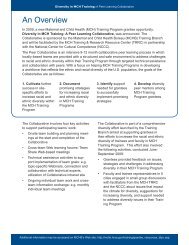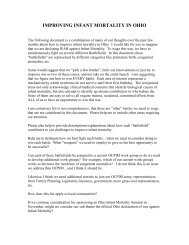A Framework for Evaluating Systems Initiatives
A Framework for Evaluating Systems Initiatives
A Framework for Evaluating Systems Initiatives
- No tags were found...
Create successful ePaper yourself
Turn your PDF publications into a flip-book with our unique Google optimized e-Paper software.
8) Hold some systems initiatives, but not all, accountable <strong>for</strong> demonstrating beneficiaryImpacts. One of the most common questions about systems initiatives is whether they should beaccountable <strong>for</strong> demonstrating their impacts <strong>for</strong> intended beneficiaries. This paper showed that<strong>for</strong> some initiatives, this expectation is warranted. For example, initiatives that scale up systemsshould be able to demonstrate such impacts. Every initiative, however, should not be held tothis measurement expectation. For some initiatives—namely those focused primarily on contextor infrastructure—beneficiary impacts are far removed from the initiative’s actual work. Whilethe hope is that any positive outcomes these initiatives achieve will play out later <strong>for</strong> the system’sbeneficiaries, and the initiative’s theory of change should clearly describe how that process willoccur, it makes little sense <strong>for</strong> these evaluations to collect data that document such impacts.9) Be clear about the initiative’s role in addressing inequities and reducing disparities. Sofar, most of the paper’s discussion has been at a conceptual and color-blind level, talking aboutbeneficiaries without specifying who they might be. The term “beneficiary” was selected <strong>for</strong>broad applicability to systems initiatives, as initiatives might focus on infants, youth, families,seniors, working families, or some other societal grouping. At the same time, most systemsinitiatives aim to improve the well-being of beneficiaries that differ on socioeconomic status,race, ethnicity, and culture. They address the profound achievement, health, wealth, occupation,justice system involvement, and basic opportunity gaps that exist in this country.While systems initiatives often are framed as serving “all families” or recognizing that “all childrenare at risk,” in reality this risk and the need <strong>for</strong> better systems responses to it are not spread evenlyacross populations. A fundamental goal of systems initiatives should be to redress these inequities.Some systems initiative outcomes—such as universally-available preschool, medical and familyleave policies that enable parents to stay home with their infants and toddlers, and public subsidiesthat raise the quality of all child care arrangements—may produce benefits <strong>for</strong> children overall, butbecause they create “a rising tide that raises all ships,” they do not close gaps.For both planning and evaluation purposes it is important to be explicit about initiative goals inthis area, even if the systems initiative is framed to benefit all beneficiaries. Evaluations’ richestfindings often are from examinations of outcomes and impacts <strong>for</strong> different subgroups in thebeneficiary population. Programs benefit from this knowledge as they can see where their ef<strong>for</strong>tsare successful and where corrections are needed.Also, although well beyond the scope of this paper, attention must be given to constructingevaluations that view outcomes and impacts through a multicultural as opposed to dominantculture lens. Different cultures place different values on constructs such as family, individualism,competition, nonverbal communication, and community that often are not reflected in systemsthat the dominant culture develops. 44 Addressing these issues goes well beyond an evaluator’srole (if systems initiatives are to address opportunity inequities and gaps, the initiatives themselvesneed to address ethnicity, culture, and language issues), but evaluators can help raise these issues.44For a discussion of this issue with respect to “developmentally appropriate” practices within the early childhood field, see: Bruner, C. (2007) Villagebuilding and school readiness: Closing opportunity gaps in a diverse society. Des Moines, IA: The State Early Childhood Policy Technical AssistanceNetwork (SECPTAN); Ray, A., Bowman, B., & Robbins, J. (2006). Preparing early childhood teachers to successfully educate all children. Chicago,IL: The Erikson Institute.33A <strong>Framework</strong> <strong>for</strong> <strong>Evaluating</strong> <strong>Systems</strong> <strong>Initiatives</strong>















